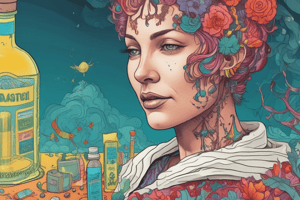Podcast
Questions and Answers
Match the following drug classes with their primary effects:
Match the following drug classes with their primary effects:
Stimulants = Reduce activity of the CNS Depressants = Alter sensation and perception Opioids = Produce euphoria and analgesia Hallucinogens = Block reuptake of neurotransmitters
Match the following psychoactive drugs with their mechanism of action:
Match the following psychoactive drugs with their mechanism of action:
Stimulants = Block reuptake of dopamine, norepinephrine, and serotonin Depressants = Increase CNS activity Opioids = Activate opioid receptor neurons Hallucinogens = Stabilize neurotransmitter levels
Match the drugs to their common effects:
Match the drugs to their common effects:
Stimulants = Slower breathing Depressants = Increased alertness Opioids = Constipation and slower breathing Hallucinogens = Altered perception of time
Match the class of drugs with its description:
Match the class of drugs with its description:
Match the following drug classes with their typical examples:
Match the following drug classes with their typical examples:
Match the following classes of drugs with their characteristics:
Match the following classes of drugs with their characteristics:
Match the following drug classes with their primary neurotransmitter effects:
Match the following drug classes with their primary neurotransmitter effects:
Match the classes of drugs with their general effects on the central nervous system:
Match the classes of drugs with their general effects on the central nervous system:
Match the following psychoactive drug classes with their potential therapeutic uses:
Match the following psychoactive drug classes with their potential therapeutic uses:
Match the following drug classes with their effects on breathing:
Match the following drug classes with their effects on breathing:
Flashcards are hidden until you start studying
Study Notes
Stimulants
- Stimulants are a category of psychoactive drugs that enhance alertness and energy.
- They act by blocking the reuptake of key neurotransmitters: dopamine, norepinephrine, and serotonin.
- This action occurs in the synapses, facilitating increased communication between neurons in the central nervous system.
Depressants
- Depressants are psychoactive drugs that lower the activity level of the central nervous system (CNS).
- These substances can promote relaxation, decrease anxiety, and induce sedation.
- Common examples include alcohol, benzodiazepines, and barbiturates.
Opioids
- Opioids are chemicals that engage opioid receptor neurons, located in the brain and digestive system.
- Their effects include producing euphoria, analgesia (pain relief), and slower breathing rates.
- Opioids can also lead to constipation, a common side effect due to their action on the digestive system.
Hallucinogens
- Hallucinogens are a class of psychoactive drugs that significantly alter sensation and perception.
- They can cause visual and auditory hallucinations, changing a person's experience of reality.
- Common examples include LSD, psilocybin (magic mushrooms), and mescaline.
Stimulants
- Stimulants are a category of psychoactive drugs that enhance alertness and energy.
- They act by blocking the reuptake of key neurotransmitters: dopamine, norepinephrine, and serotonin.
- This action occurs in the synapses, facilitating increased communication between neurons in the central nervous system.
Depressants
- Depressants are psychoactive drugs that lower the activity level of the central nervous system (CNS).
- These substances can promote relaxation, decrease anxiety, and induce sedation.
- Common examples include alcohol, benzodiazepines, and barbiturates.
Opioids
- Opioids are chemicals that engage opioid receptor neurons, located in the brain and digestive system.
- Their effects include producing euphoria, analgesia (pain relief), and slower breathing rates.
- Opioids can also lead to constipation, a common side effect due to their action on the digestive system.
Hallucinogens
- Hallucinogens are a class of psychoactive drugs that significantly alter sensation and perception.
- They can cause visual and auditory hallucinations, changing a person's experience of reality.
- Common examples include LSD, psilocybin (magic mushrooms), and mescaline.
Studying That Suits You
Use AI to generate personalized quizzes and flashcards to suit your learning preferences.




